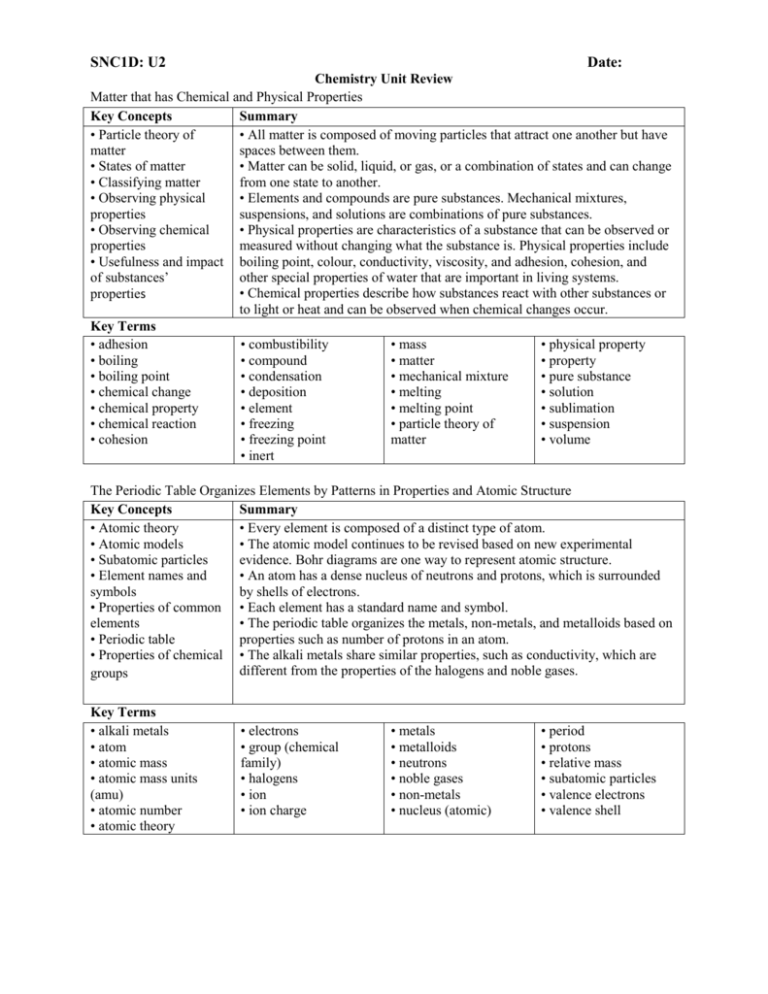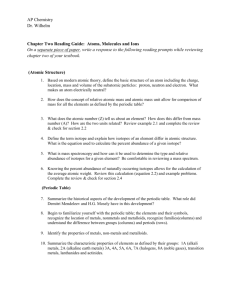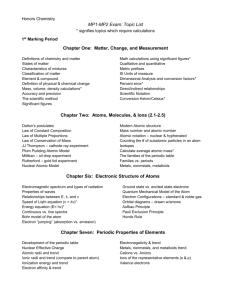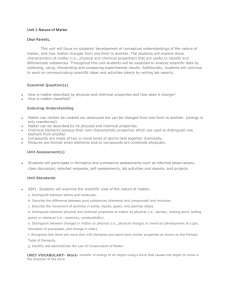File
advertisement

SNC1D: U2 Date: Chemistry Unit Review Matter that has Chemical and Physical Properties Key Concepts Summary • Particle theory of • All matter is composed of moving particles that attract one another but have matter spaces between them. • States of matter • Matter can be solid, liquid, or gas, or a combination of states and can change • Classifying matter from one state to another. • Observing physical • Elements and compounds are pure substances. Mechanical mixtures, properties suspensions, and solutions are combinations of pure substances. • Observing chemical • Physical properties are characteristics of a substance that can be observed or properties measured without changing what the substance is. Physical properties include • Usefulness and impact boiling point, colour, conductivity, viscosity, and adhesion, cohesion, and of substances’ other special properties of water that are important in living systems. • Chemical properties describe how substances react with other substances or properties to light or heat and can be observed when chemical changes occur. Key Terms • adhesion • combustibility • mass • physical property • boiling • compound • matter • property • boiling point • condensation • mechanical mixture • pure substance • chemical change • deposition • melting • solution • chemical property • element • melting point • sublimation • chemical reaction • freezing • particle theory of • suspension • cohesion • freezing point matter • volume • inert The Periodic Table Organizes Elements by Patterns in Properties and Atomic Structure Key Concepts Summary • Atomic theory • Every element is composed of a distinct type of atom. • Atomic models • The atomic model continues to be revised based on new experimental • Subatomic particles evidence. Bohr diagrams are one way to represent atomic structure. • Element names and • An atom has a dense nucleus of neutrons and protons, which is surrounded symbols by shells of electrons. • Properties of common • Each element has a standard name and symbol. elements • The periodic table organizes the metals, non-metals, and metalloids based on • Periodic table properties such as number of protons in an atom. • Properties of chemical • The alkali metals share similar properties, such as conductivity, which are different from the properties of the halogens and noble gases. groups Key Terms • alkali metals • atom • atomic mass • atomic mass units (amu) • atomic number • atomic theory • electrons • group (chemical family) • halogens • ion • ion charge • metals • metalloids • neutrons • noble gases • non-metals • nucleus (atomic) • period • protons • relative mass • subatomic particles • valence electrons • valence shell Elements Combine to Form Ionic Compounds and Molecular Compounds Key Concepts Summary • Compounds • Compounds are pure substances composed of atoms of two or more elements • Chemical bonds that are joined by chemical bonds. • Chemical names and • Ions with opposite charges attract each other in ionic compounds, while formulas atoms in molecules share valence electrons. • Using elements and • The formulas for many common compounds can be determined from their names, and vice versa. compounds • How we make use of electrons and compounds affects society, the economy, and the environment. Key Terms • bond • ionic bonds • molecular compound • parts per million • chemical formula • ionic compounds • molecules (ppm) Questions: 1. What is the main difference between a pure substance and a mixture? Name an example of each. 2. What is a chemical change? 5. Explain the difference between cohesion and adhesion, using an example. 6. Explain why particles of water in the air can form frost on a cold window. 7. Name a physical property that is: (a) shared by gold, copper, and iron (b) shared by gold and copper but not iron 12. Classify and compare the following mixtures. (a) a drink made by dissolving drink crystals in water (b) a cup of tea with tea leaves in it (c) tomato juice 13. How can the application of heat result in a chemical change? Explain, using an example. 15. If water freezes inside of a building’s water pipes, the pipes may burst. Explain why this happens. ---------1. What is the smallest amount of an element that can exist? 2. Compare and contrast the charge, the location in an atom, and the relative mass of an electron with those of a neutron. 3. Beginning with the innermost shell, list the maximum number of electrons that an atom can have in its first three shells. 8. (a) If an atom has 43 protons, what element is it?(b) If an atom contains 66 electrons, what element is it? 10. Draw a Bohr diagram of a chlorine atom. 11. Draw a Bohr diagram of a chlorine ion. More Questions 55. Use the Bohr diagrams below to answer the questions that follow. 1. Define the term “compound.” Give an example. 2. (a) H2O2 What elements are present in this substance and in what ratio? (b) Identify hydrogen peroxide as an ionic compound or a molecular compound. (a) nitrogen(b) lithium (c) aluminum (d) oxygen (e) chlorine (f) sodium (g) xenon (h) copper 4. Write the chemical name for each of the following ionic compounds. (a) KI (b) CaCl2 (c) AlBr3 5. Write the formula for each of the following ionic compounds. (a) lithium nitride (b) iron(II) chloride (c) sodium hydroxide 6. Write the chemical name for each of the following molecular compounds. (a) PF5 (b) Cl2O3 (c) CF4 7. Write the formula for each of the following molecular compounds. (a) nitrogen monoxide (b) carbon disulphide (c) phosphorus tribromide 11. (a) What is the main difference between ionic bonds and the bonds in a molecule? (b) Which generally have higher melting temperatures: ionic compounds or molecular compounds? More Questions page 288 # 1-41, page 294 self quiz Indicate whether or not each of (a) Name the elements shown. (b) Did the ion shown in B form by losing an electron or gaining an electron? (c) Would the atom shown in A be likely to be found in an ionic compound? Explain. (d)Would the ion in B be more likely to bond with Ca2+ or with O2–? Explain. 56. Draw Bohr diagrams to depict atoms of the following elements. (a) oxygen (b) sodium (c) hydrogen






